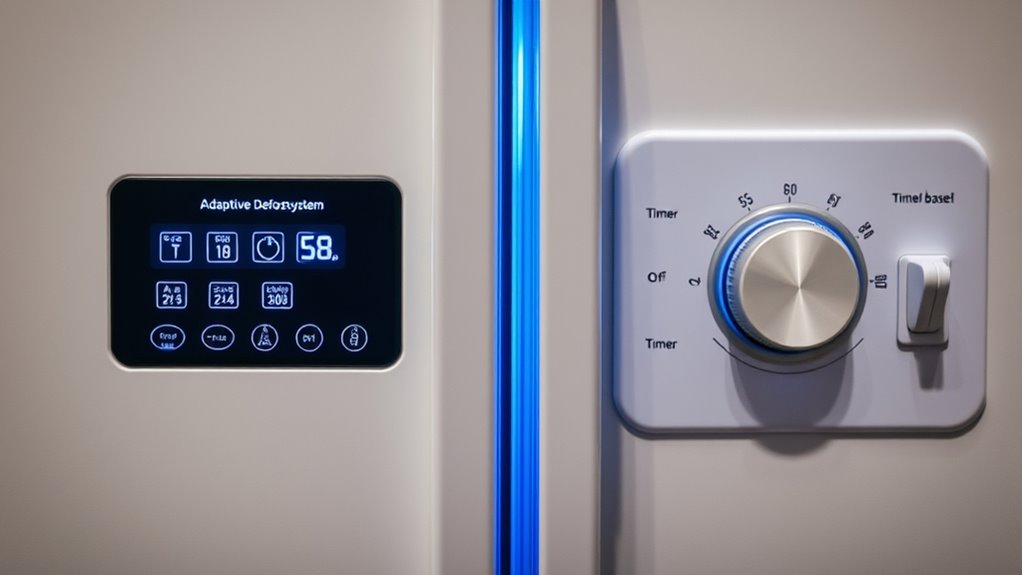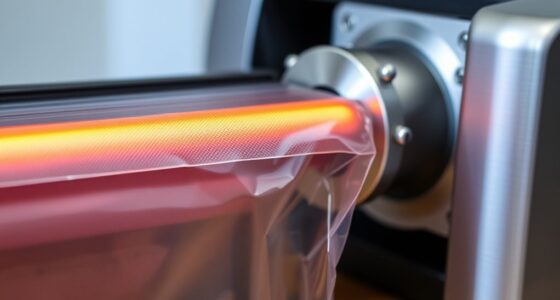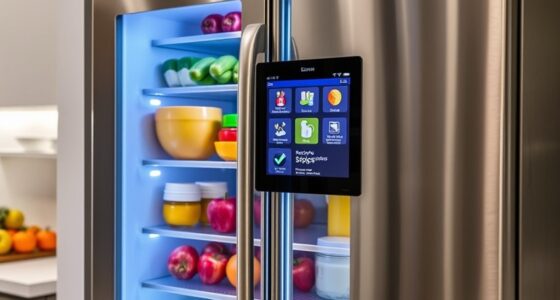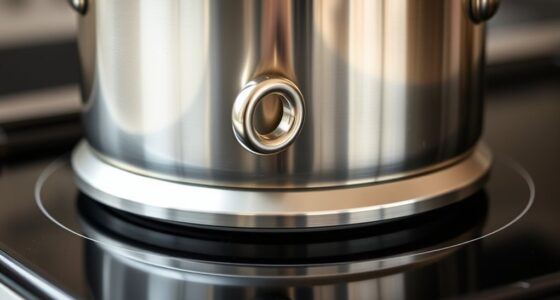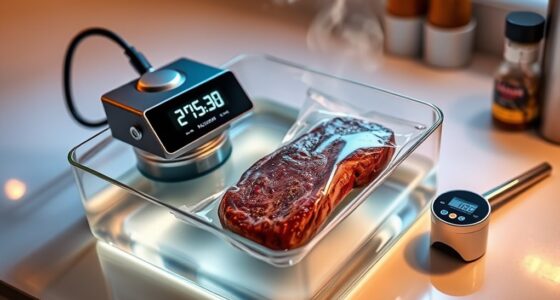Timer-based defrost systems rely on preset schedules, which can cause temperature fluctuations, risking food safety, and wasting energy. Adaptive systems use sensors and smart controls to activate defrost only when needed, maintaining more consistent temperatures and reducing frost buildup. They’re often more energy-efficient and gentle on your appliances, helping prolong lifespan. If you want to understand how these systems compare in cost, performance, and benefits, you’ll find helpful details as you explore further.
Key Takeaways
- Timer-based systems schedule defrost cycles at fixed intervals without sensing actual frost buildup.
- Adaptive systems use sensors and algorithms to activate defrost only when needed, improving efficiency.
- Adaptive defrost maintains more stable temperatures, reducing food spoilage and extending shelf life.
- Energy savings are greater with adaptive systems, which can use up to 80% less energy than timer-based models.
- Adaptive defrost enhances appliance lifespan and reduces maintenance by preventing unnecessary defrost cycles.
How Timer-Based Defrost Systems Work

Timer-based defrost systems operate by using a clock mechanism to schedule when the defrost cycle occurs. You set a timer that triggers at preset intervals, like every six hours, to start the defrost process. During this cycle, a heating element melts the frost on the evaporator coils, while the compressor and fans shut off to prevent cooling. The defrost duration is fixed or controlled by the timer, typically around 30 minutes, and it stops either when the timer completes or a thermostat detects the coil has warmed above a set temperature, such as 5°C. Some systems include pressure switches or thermostats to terminate defrost early if needed. To prevent overheating, a fail-safe timer limits the maximum defrost time, usually around 40 minutes. Incorporating high-quality components can improve the longevity and efficiency of timer-based systems.
Features of Adaptive (Demand-Initiated) Defrost Systems
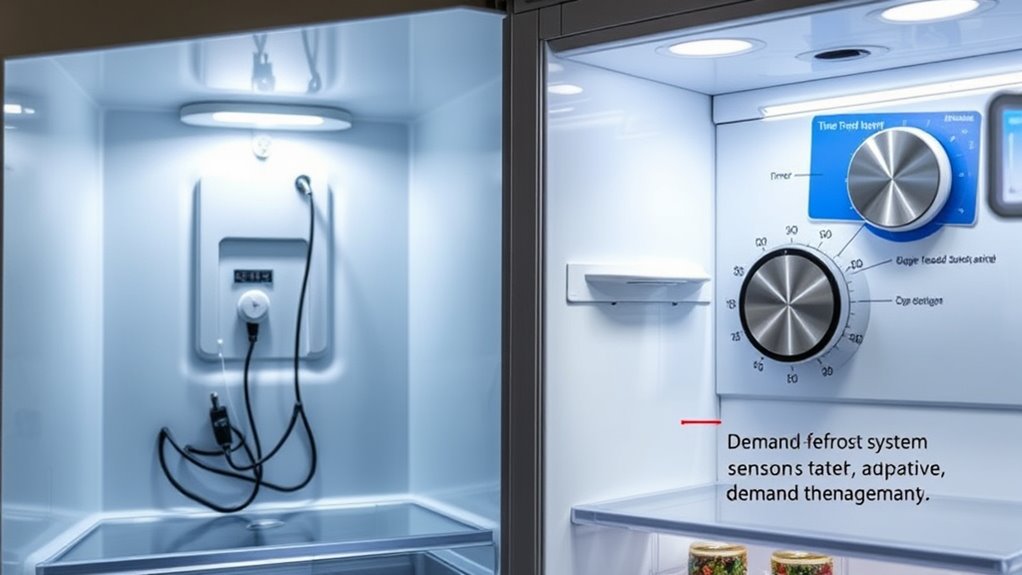
Adaptive defrost systems operate based on actual usage conditions instead of fixed schedules. They monitor door openings, compressor run times, and frost buildup to determine when defrosting is needed. When frost increases, defrost cycles shorten; when frost is minimal, cycles lengthen. This approach prevents unnecessary energy use while avoiding excessive frost. The system uses algorithms and sensors to calculate the best defrost timing and duration, relying on temperature sensors on the evaporator coil for precise cycle termination. Real-time data ensures better temperature stability and reduces maintenance. Additionally, advanced sensors can detect humidity levels to further optimize defrost timing and improve overall appliance efficiency. The following table summarizes key features:
| Feature | Benefit |
|---|---|
| Usage-based scheduling | Saves energy by avoiding unnecessary defrosts |
| Sensor-driven frost detection | Ensures defrost occurs only when needed |
| Real-time monitoring | Maintains consistent temperature and prolongs appliance life |
Comparing Temperature Stability and Food Preservation
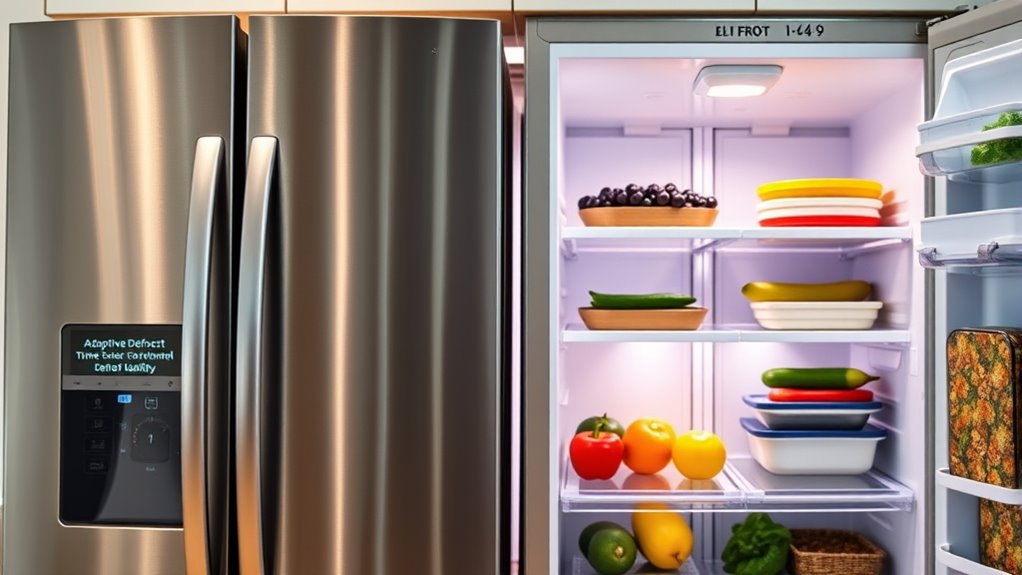
You’ll notice that temperature stability directly impacts how well your food stays fresh and safe. Timer-based systems can cause fluctuations that may harm delicate items, while adaptive systems maintain more consistent conditions. By comparing these approaches, you can see which offers better control over food preservation and overall quality. Additionally, adopting advanced security features can help protect your appliances and ensure optimal performance. Understanding how tuning and modifications influence vehicle performance can also serve as a useful analogy for appreciating the importance of precise control systems in appliances.
Temperature Fluctuation Control
Maintaining consistent temperatures during defrost cycles is essential for preserving food quality in freezers. Adaptive defrost systems use sensors to detect ice buildup, activating defrost only when needed, which minimizes temperature fluctuations. This results in fewer temperature spikes and quicker recovery times—about one hour after door openings—helping food stay frozen and maintaining texture. In contrast, timer-based systems run defrosts at fixed intervals regardless of frost levels, causing more frequent temperature swings and longer recovery periods of around 3.5 hours. These fluctuations increase the risk of freezer burn and nutrient loss. Adaptive systems promote even temperature distribution and dry air, supporting better preservation. Additionally, temperature stability helps reduce energy consumption by preventing unnecessary defrost cycles. Proper temperature regulation is crucial for optimal food storage and safety. Overall, adaptive control offers superior temperature stability, safeguarding your food from damage caused by temperature fluctuations.
Food Safety Consistency
Since temperature stability directly impacts food safety, refrigerators with adaptive defrost systems offer a significant advantage over timer-based models. Adaptive systems minimize unnecessary defrost cycles, keeping temperatures consistently at or below 40 °F, which is vital for slowing bacterial growth. In contrast, timer-based systems cause frequent warm-up periods, raising the risk of food entering the bacterial “Danger Zone.” These fluctuations can accelerate microbial proliferation, threatening food safety. Adaptive defrosting ensures foods stay in safe temperature ranges longer, preserving quality and extending shelf life. It also prevents excessive moisture and ice crystal formation that can damage food texture. By maintaining stable temperatures, adaptive systems support safe thawing and reduce spoilage, ultimately helping you keep food safer and fresher for longer. Implementing safe food storage practices alongside advanced defrost systems further enhances food safety and quality. Additionally, consistent temperature control reduces the likelihood of food spoilage caused by temperature fluctuations.
Energy Efficiency of Different Defrost Technologies
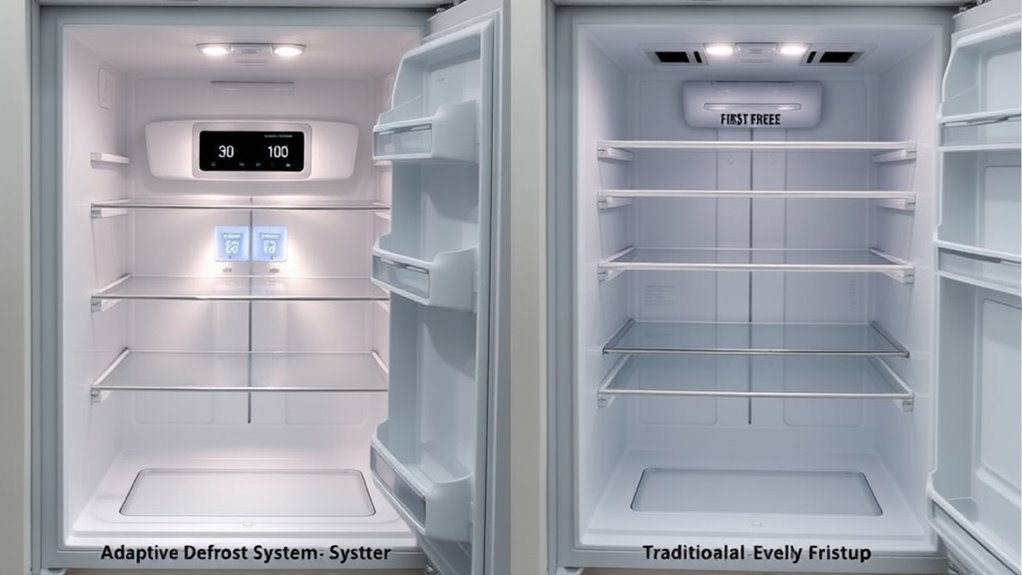
You can save energy by choosing the right defrost technology, as demand systems use up to 80% less power than timer-based models. Manual defrost appliances also consume markedly less energy because they avoid continuous heating cycles. By understanding how each system prevents frost buildup efficiently, you can make smarter choices that reduce overall power consumption.
Power Consumption Differences
Different defrost technologies substantially impact a refrigerator’s energy consumption, with adaptive systems generally consuming less power than traditional timer-based models. Adaptive defrost activates only when sensors detect frost buildup, minimizing heater operation and reducing energy use. In contrast, timer-based systems run defrost cycles at fixed intervals, often unnecessary, leading to higher energy consumption. The energy saved mainly comes from less defrost heater use and fewer compressor restarts. Studies show adaptive systems can cut defrost-related energy by 10–20%. You’ll also see efficiency gains through smoother compressor operation, since adaptive controls optimize cycle timing.
- Adaptive systems limit defrost heater operation to necessary moments
- Timer-based models often cycle more frequently, wasting energy
- Reduced heater use decreases overall electricity costs
- Fewer compressor restarts lower peak power spikes
- Modern adaptive systems contribute to significant annual energy savings
Frost Prevention Efficiency
Frost prevention efficiency varies markedly between adaptive and timer-based defrost systems, affecting how effectively your refrigerator manages frost buildup while conserving energy. Adaptive systems adjust defrost cycles based on actual frost levels, preventing unnecessary defrosting and maintaining ideal conditions. Timer-based systems run on fixed schedules, which can lead to over- or under-defrosting, reducing efficiency. Both systems prevent frost buildup effectively, but adaptive models better minimize frost accumulation and system strain, keeping frost less than 0.25 inches. This prevents excess energy use and maintains consistent temperatures. Frost accumulation can be minimized further through proper maintenance and load management. Frost-free models rely on advanced air circulation, reducing moisture and frost, but may dry out produce if airflow isn’t optimal. Overall, adaptive defrost systems are more efficient in controlling frost, lowering energy consumption, and extending the appliance’s lifespan. Additionally, understanding hacks used in remote hackathons can inspire innovative approaches to optimize appliance performance and energy management.
Maintenance and User Convenience Considerations
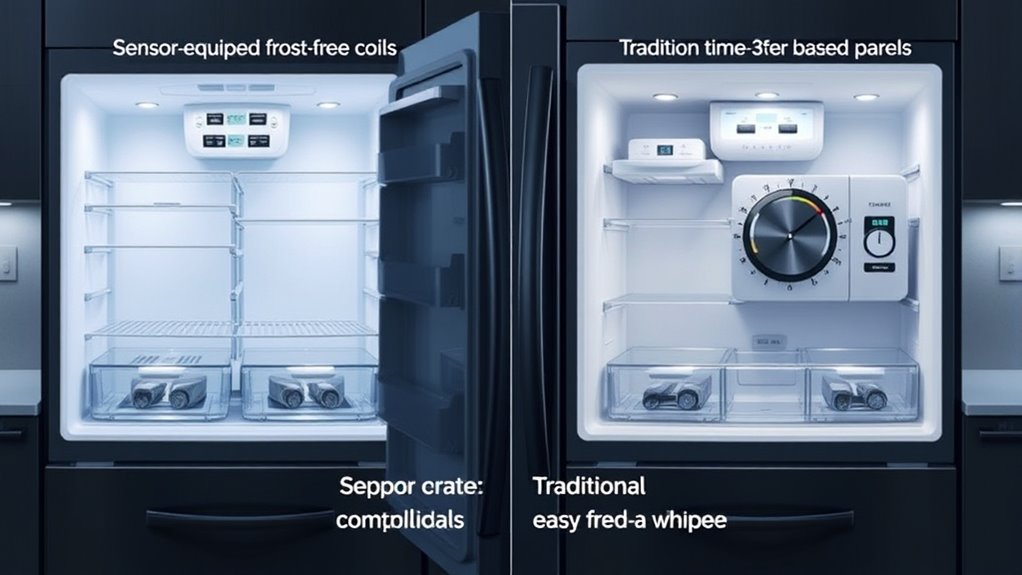
Adaptive defrost systems offer several maintenance and user convenience advantages, but they also introduce new considerations. You might appreciate fewer defrost cycles, which reduce wear on components and cut down on manual cleaning. They also prevent ice buildup, helping your fridge run efficiently and prolonging heater and thermostat lifespan. However, these systems rely on sensors and control boards that may need professional repairs if they fail, potentially increasing costs. Troubleshooting can be complex, especially if components like thermostats or drain systems malfunction. For convenience, adaptive cycles are less noisy and more energy-efficient, but they can sometimes misjudge frost load, causing irregular defrost intervals. Additionally, the absence of a fixed schedule might complicate planning for maintenance or routine tasks. Visual cues like dripping or heater glow help, but may be misunderstood. Incorporating well-being tips into your routine can also help reduce stress caused by appliance maintenance issues. Understanding the sensor technology behind adaptive systems can help you better recognize normal operation versus signs of malfunction.
Advantages and Disadvantages of Timer-Based Systems

Timer-based defrost systems are valued for their simplicity and cost-effectiveness, making them a popular choice for basic refrigeration units. They operate on fixed intervals, which makes them mechanically simple, easier to design, and less expensive upfront. With fewer components like sensors, they reduce the risk of failures and simplify troubleshooting. Additionally, their predictable operation also leads to energy inefficiency, as cycles may activate unnecessarily or run longer than needed, wasting electricity. The lack of real-time frost detection can cause excessive heating, impacting energy costs and food quality. Moreover, mechanical timers can wear out or drift, affecting performance over time. While reliable for basic needs, these systems may lead to temperature fluctuations and increased maintenance, especially in environments with variable conditions.
Benefits of Adaptive Defrost in Modern Refrigeration

Modern refrigeration systems benefit considerably from adaptive defrost technology because they can detect actual frost buildup and adjust defrost cycles accordingly. This targeted approach helps prevent unnecessary defrosting, saving energy and reducing operating costs. By monitoring parameters like temperature, pressure, and usage data, the system activates defrost cycles only when needed, maintaining ideal food quality and shelf life. Additionally, adaptive defrost minimizes temperature fluctuations, helping preserve food texture, flavor, and nutritional value. It also extends equipment lifespan by reducing wear on components like compressors and fans. The intelligent control adapts to changing usage patterns and ambient conditions, ensuring consistent performance. Incorporating cost‑of‑ownership math into the system design can further optimize long-term savings and maintenance planning. Moreover, integrating advanced sensors can enhance frost detection accuracy, leading to even more efficient defrost cycles.
Frequently Asked Questions
Can a Refrigerator Switch Between Timer-Based and Adaptive Defrost Modes?
Yes, some refrigerators can switch between timer-based and adaptive defrost modes, but it’s not common in household models. Usually, this feature is found in advanced or commercial units with programmable control boards. You may need to access the control panel or firmware settings to change modes, often during installation or servicing. Most standard home refrigerators don’t offer user-accessible switching, so check your appliance’s specifications before attempting any adjustments.
How Does Frost Buildup Affect Energy Consumption in Different Defrost Systems?
Frost buildup acts like a heavy blanket, trapping heat and forcing your compressor to work harder, which spikes energy use. In timer-based systems, unnecessary defrosts waste power, while frost can cause near-double compressor run times. Adaptive systems, on the other hand, sense frost levels and only defrost when needed, keeping energy consumption lower. Proper defrosting maintains efficiency, saving you money and reducing environmental impact.
Are There Specific Signs Indicating the Need to Replace a Defrost System?
If you notice excessive frost buildup, continuous running, warm compartments, or unusual noises, it’s time to replace the defrost system. Signs include ice over the coils that won’t melt, failure of the fridge to cycle into defrost mode, or increased energy use. Testing components like the heater, thermostat, and timer will confirm the issue. When these parts fail or tests show faults, replacing the entire system prevents further damage and restores proper cooling.
What Are the Typical Costs Associated With Repairing Auto-Defrost Components?
You’ll spend between $100 and $440 to repair or replace a defrost motor, which is a common repair cost. Curiously, thermostat replacements can range from $26 to $440, and control board fixes often hit $300 to $650. Labor adds to these costs, usually 1-3 hours, but DIY repairs on simpler parts like sensors can save you money. Expect total expenses to vary based on your fridge’s make, model, and location.
How Do Defrost System Choices Impact the Lifespan of a Refrigerator?
Choosing an adaptive defrost system can markedly extend your refrigerator’s lifespan because it reduces wear on components, maintains consistent temperatures, and minimizes frost buildup. On the other hand, timer-based systems may cause more frequent heating cycles, leading to faster wear and potential early failure. By selecting an adaptive system, you benefit from increased reliability, fewer maintenance needs, and longer-lasting performance, ultimately saving you money and hassle over time.
Conclusion
As you consider your refrigerator’s defrost system, the choice between timer-based and adaptive models isn’t just technical—it’s about the future of your food’s freshness. Will the traditional timer keep pace with evolving needs, or will the demand-initiated system reveal unseen benefits? The decision could redefine convenience, efficiency, and preservation. Stay tuned—what you choose today might just surprise you tomorrow.
